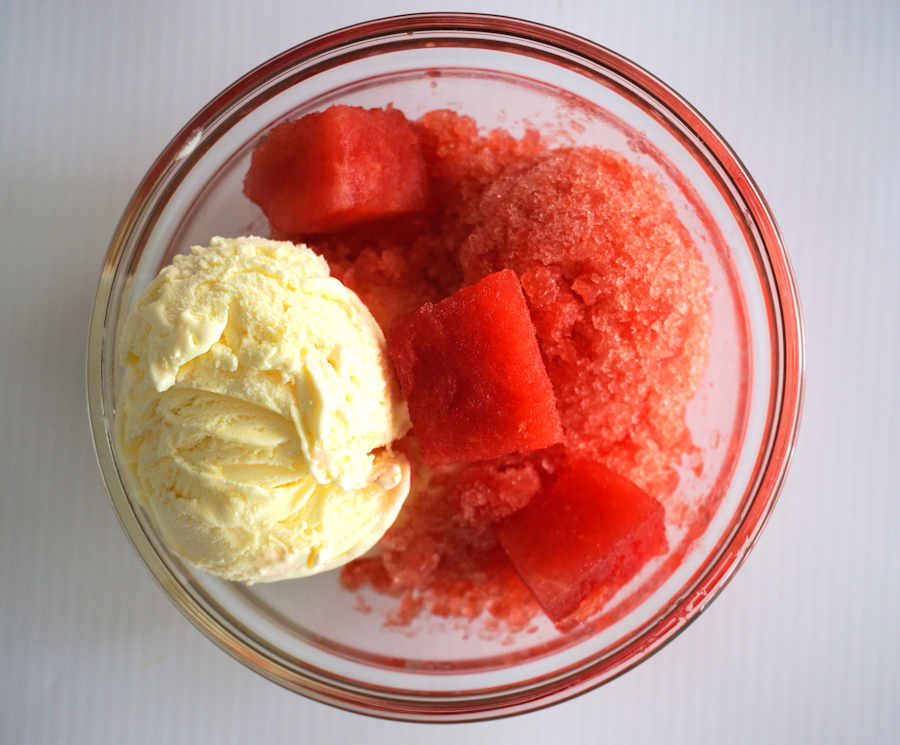Watermelon granita ice: how to boost your dessert without a massive calorie increase.

Watermelon gives you enormous bang for your buck. Buy a quarter, and you’ll still be eating it five days later. I know, it’s just sugar and water, but it’s certainly better to get your sugar fix that way rather than with a caramel frapuccino. Plus, it contains electrolytes which remineralise your body after sun and heat.
How to handle watermelon?
But it is not a little unwieldy – let alone the whole medicine ball of it, even a quarter usually leaves me daunted. When I was a kid, I’d be given a tranche and sent outdoors, to bite into it like a child version of Joker, spit out pips and attract the wasps like no tomorrow.
But now? I’d wish to do something cheffier, more presentable and interestingly flavoured with it. But how to commence?
How to cut watermelon into cubes
Here’s how, and it's easy.
Depending on the size, cut the watermelon into quarters or eights with a very sharp and a very large knife. I have cheated on this step, having bought only a quarter.
There are allegedly seedless watermelon varieties but mine is the old-fashioned, black-pipped one. I need to identify the seed layer, running in a crescent halfway down the tranche, and slice the flesh off just above it. Don’t discard it! That’s precisely our dessert ingredient!
With a large fork scrape the seeds out, it’s even easier done than said. You can trim the rough surface post-scraping if you want very neat cubes, otherwise/then make incisions into the flesh down to the white rind, every 2cm or so.
Then, like a karate ninja, make a sweeping cut along the base to release the chunks, and cut them into cubes.
What to do with leftover watermelon flesh?
Why, here our recipe begins.
If you have a food mill, a nifty tool that purees and deseeds stuff, scoop all the flesh, pips and juice into it and pass into a bowl through a medium mesh.
If you don’t, push it through a sieve. That’s a little more laborious, but I love the whole concept of a recipe based on by-product. It’s fighting waste! Making a dessert from scraps!
What is granita?
Granita is frozen fruit juice or puree. But just so you don’t get an enormous cube of fruit ice, it has to be broken up as it freezes.
Which is actually very easy to do. It’s best to make granita about two hours before serving, it will be the optimal texture at that point.
You can let it freeze deep and let it sit on the counter before serving, as you do with ice cream, but you risk of lumps of ice swimming in the juice in the tub if you miss the right moment.
How to make watermelon (and any other) granita
The juice should freeze in a shallow container, to speed things up. Every half an hour remove it from the freezer and scrape and mash it with a fork, breaking up big ice lumps. Back in the freezer for another half an hour, then repeat.
It can be eaten/drank as is, of course, like a Slush Puppy of sorts but I think it’s divine added to ice cream.
A scoop of vanilla or clotted cream, with a scoop of granita: that’s half the ice cream, full dessert. Even if it can't be neatly scooped, a mound of granita next to or underneath a generous dollop of ice cream will look pretty decorative and taste amazing.
Granita strawberry variation
You can make granita from pretty much any juicy fruit, but strawberries are simply gorgeous in the frozen, slushy form.
If you have a bowl slightly past their best, trim and chop them, then puree or blend them and make granita, proceeding in exactly the same way as with the watermelon.
Serve with bland ice cream for an almighty zing; with strawberry ice cream for a double-berry whammy, or with chocolate ice cream for the contrast of flavours and textures.
P.S. If you run out of ice cream, whip some barely sweetened cream, then fold the granita into it and serve.